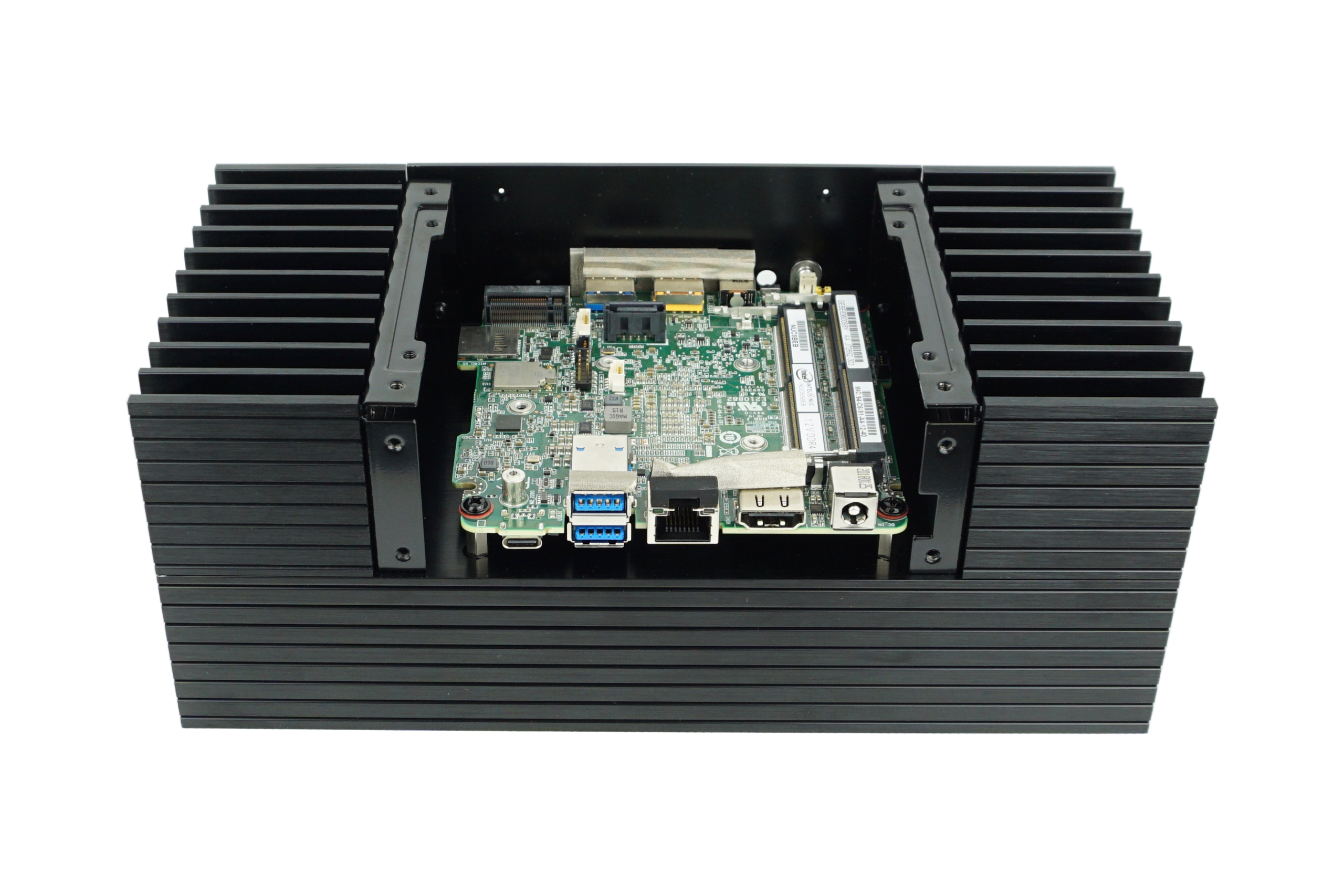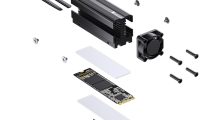Testing the cooling
For the test of the cooling of the Akasa Turning, it must be noted that due to the thermal mass of the housing, the heat development increases over a longer period of time until a balance is observed. This equilibrium consists of the absorbed heat energy and the simultaneous identical amount of thermal quantity. This only starts at a later time, when the housing has heated up and so warm that the convection disperses the same energy on the cooling fins.
As a result, quick shots are not meaningful, as temporary loads are easily swallowed by the sheer mass of aluminum.

The Intel XTU tool was used to test cooling performance to set, read and test CPU parameters. Because the Akasa Turing is completely unimpressed by the "stock" settings of the processor. The Cinebench R20 tool tested whether the cooling also affects the performance of the CPU.
A brief excursion into the behavior of the Intel Core i5-8259U processor and a few key data:
- Cores/Threads: 4/8
- Base clock: 2.3GHz
- Max. Turbo clock: 3.8GHz
- TDP: .28W
- Turbo TDP: .50W
The turbo clock of the CPU is limited by the power consumption and the temperature of the CPU. Of course, other parameters are also responsible for controlling the clock, but these two values are sufficient for a simple viewing.
Intel allows the CPU for approx. 90 seconds more than swallowing the set 30 watts of power and consuming 50 watts in that time – with the condition not to overheat! If the CPU gets too hot, the CPU throttles its consumption and thus its clock. Only with power X is bar Y possible, so these values basically go hand in hand. This can be optimally recognized by the course of the "Thermal Throttling", i.e. the choke due to prevailing heat.
Let's take a closer look at the history of CPU temperature, power consumption, and CPU clock over the duration of a Cinebench R20 run.

With the original NUC housing, you can see that the cooling with the turbo of the CPU is overwhelmed and it cannot cool sufficiently. The fans turn up clearly and make themselves noticeable.
The Intel XTU graphic shows that at 100% load through Cinebench, the CPU briefly raises the TDP to 50 watts (green), which allows the CPU to increase the boost of approx. 3.8GHz (orange). However, due to the rising temperature (turquoise) this is lowered from the reach of the Thermal Throttling (red) by reducing the TDP. The throttling extends over the entire turbo boost and results in a constant lowering of TDP and clock. After 90 seconds, the CPU is captured by the end of the turbo to 30 watts and only clocks with a maximum of approx. 3GHz. In Cinebench, this is 1594 points.
With a little "fine tuning" of the CPU, the voltage of the CPU can be lowered. -75mV were possible without stability problems and allow the processor to hold the boost longer. Thus 1685 points were possible.

If the time limit of the turboboost is now lifted, the CPU runs permanently in the thermal limit and constantly lowers its clock, but a further better result is achieved: 1794 points.

What are the results in Akasa Turning? I have already indicated that the housing loosely puts away such short loads allows the CPU to always keep in maximum tact. Neither the temperature, but only the TDP limit the performance.
With stock values, 1622 points were achievable in my test runs. A slightly better result thanks to the potent cooling.

With 75mV less voltage, 1670 points can be recorded, similar to the active cooling by the original NUC housing.

Without limiting the TDP, the Akasa Turning can keep the CPU at a constant 3.6GHz without running into the thermal limit of the CPU. This was 1804 points. Again slightly more than with the active cooling.

With stick settings, the cooling was tested for more than an hour with the conversion of a 4k film into handbrake. You can see that the CPU can constantly "boost" and never runs into the thermal limit. The CPU temperature remains constantly high, but can still work with the adjacent 30 watts in a safe range.

With a constant increase of the TDP to 50 watts, the cooling of the Akasa Turing is still overwhelmed in the end and causes the CPU to throttle. Despite a longer,longer, point-by-point peak performance and a permanently better basic performance, the processor can only operate within the given "environmental conditions", i.e. the capacity of passive cooling.
In the last picture you can see how long the COOLING of the CPU takes after a long continuous load, because the heated housing has to cool down first. The processor is not immediately cool again.

Conclusion
The Akasa Turing fulfils its full purpose. The cooling of the processor works perfectly and due to the high thermal mass of the housing, even capacities are available for a little more power consumption. The conversion of the NUC into the Turing is very easy by hand and is also user-friendly. Thanks to the enclosed thermal paste from Akasa, you only need a screwdriver for installation. Unfortunately, the price of turing is relatively high and, especially in contrast to the low price of an Intel NUK, probably not proportionate. But if you have the goal to cool your NUC silently, the Akasa Turing is also under constant load at the right address.
Akasa Turing, OEM (A-NUC45-M1B)
 | Auf Lager, Lieferzeit 2-3 Werktage | 116,55 €*Stand: 19.04.24 17:50 |
 | lagernd | 119,95 €*Stand: 19.04.24 16:00 |

































Kommentieren